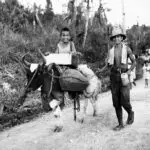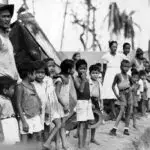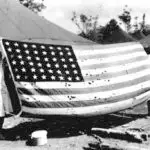Adoption of "Guamanian"



Table of Contents
Share This
Adoption of "Guamanian"
“Guamanian,” a term that evolved in the early years after World War II, was informally adopted as a means to distinguish between the Chamorros from Guam and the Chamorros from what is now the Commonwealth of the Northern Mariana Islands. The Mariana Islands were first colonized by Spain following the arrival of Ferdinand Magellan in the sixteenth century.
The Treaty of Paris of 1898, in an effort to end the Spanish-American Wars, mandated the ceding of Guam to the United States, whereas, the rest of the Marianas were ceded to Germany, thus beginning a long history of geo-political divisions among Chamorros. While Guam remained under US military control up to the outbreak of World War II, the Northern Mariana Islands would be transferred from German to Japanese control during World War I. By the end of the second World War, the US would retake control of all the Mariana Islands.
In the years following the retaking of Guam by the US military in 1944, the military government commonly referred to the indigenous population as “natives” or “Chamorros.” But “Chamorro” did not adequately reflect the geo-political distinctions that in the previous century had put the people of the Marianas on opposite sides of political borders. Given the history of changing foreign administration of the islands, it was necessary for the military and media alike to distinguish between the populations of these two areas.
Navy wanted new name for Guam Chamorros
The request for a new naming convention was thus initiated by the US Naval administration, and the question was posed to the local population via a series of informal polls and contests. By 1946, though “Guamanian” was never formally adopted, it was used in practice – the ramification of which was a social redefining of a population on the cusp of a new political era.
As Guam was being rebuilt in the post-war period, so too were its people being transformed in the wake of the war’s social, political, and cultural upheaval. Significant among these changes was the replacing of “Chamorro” with “Guamanian” – the de facto term for identifying Guam’s indigenous population after World War II.
"Guamian, Guamese, Guamerican"
Deriving an identifying term from “Guam” yielded several possibilities, including “Guamian” and “Guamese.” Proposed by the Naval government, “Guamese” was vehemently rejected by Chamorros not just because of its Eastern connotations, but because of its similarity to the term “Saipanese” used to identify those from Saipan. In the two years immediately following the Japanese occupation, the island consciousness was still fresh with the memory of the Chamorros who suffered at the hands of the Japanese military. Blame for such suffering did not stop with the Japanese, however, and extended, perhaps more intensely, toward those who assisted them – in particular the Chamorros recruited from Saipan and Rota.
Instead, the Chamorros preferred “Guamerican.” Since the early years of US Naval administration, Chamorros from Guam sought US citizenship. Many regarded the merging of “Guam” with “American” as an apt reflection of Guam’s relationship with the United States. “Guamerican,” however, was rebuffed by the Naval government.
Given the contentions with these terms, “Guamanian” became the replacement term of choice. For roughly thirty years, the word was synonymous with “Chamorro.” It was a convenient term for the governing authority, and it was used interchangeably with “Chamorro” by Chamorros themselves.
Long-time residents adopted name
By the late 1970s, however, the term whose definition was initially meant to identify Guam Chamorros had evolved into an increasingly inclusive and ethnically-ambiguous term. “Guamanian” uttered in popular dialogue has come to mean not just resident Chamorros, but also long-time residents of Guam who are not necessarily Chamorro.
Though the definition of “Chamorro” is itself a point of debate for many, what became clear by the end of the twentieth century was that the term “Guamanian” no longer sufficed as an apt identifier of the people it had initially intended to rename. Today, the term remains popular, though its use among Chamorros has noticeably waned in favor of its more explicit and ethnically distinct predecessor – Chamorro.
For further reading
Perez, Cecilia CT. “A Chamorro Re-Telling of ‘Liberation’.” In Kinalamten Pulitikåt: Siñenten I Chamorro (Issues in Guam’s Political Development: The Chamorro Perspective). The Hale’-ta Series. Hagåtña: Political Status Education Coordinating Commission, 1996.
Rogers, Robert. Destiny’s Landfall: A History of Guam. Honolulu: University of Hawai’i Press, 1995.
Sanchez, Pedro C. Guahan Guam: The History of Our Island. Hagåtña: Sanchez Publishing House, 1987.
Taitano, Carlos P. “Political Development.” In Kinalamten Pulitikåt: Siñenten I Chamorro (Issues in Guam’s Political Development: The Chamorro Perspective). The Hale’-ta Series. Hagåtña: Political Status Education Coordinating Commission, 1996.
